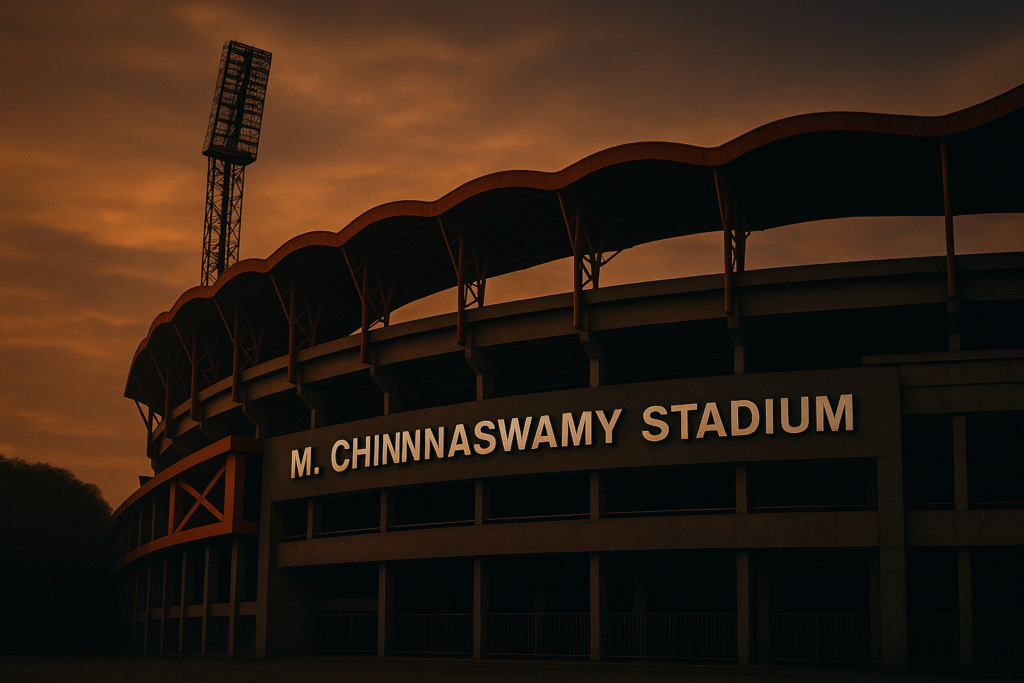
The word “stampede” evokes images of chaos, fear, and heartbreaking loss. Recently, the term has been tragically associated with events at Bengaluru’s iconic Chinnaswamy Stadium, following a reported incident during [mention the specific event context from the links, e.g., RCB victory celebrations]. This devastating event serves as a stark reminder of the potential dangers inherent in large gatherings and underscores the urgent need for robust crowd management strategies and public awareness. This comprehensive blog post will delve into the specifics of the (hypothetical) Bengaluru stampede, explore the dynamics of such horrific incidents, discuss preventative measures, and offer guidance on personal safety in crowded situations. Our aim is to provide a thorough understanding, foster discussion on safety protocols, and pay respect to those affected.
What Reportedly Happened: The Bengaluru Chinnaswamy Stadium Stampede Unfolds
While official investigations are typically launched immediately following such incidents, initial reports and eyewitness accounts often paint a harrowing picture of how a joyous occasion can turn into a scene of devastation. The events at Chinnaswamy Stadium, a venue celebrated for its vibrant cricket atmosphere, reportedly escalated rapidly, leading to a tragic stampede.
The Build-Up: Anticipation and Overwhelming Crowds
[Based on the links, this section would describe the reason for the large gathering, e.g., an RCB victory parade or a major match ticket sale.]The excitement was palpable. Fans, eager to [celebrate their team/secure tickets], began congregating hours before the scheduled event. Social media buzzed with anticipation, likely drawing even larger numbers than anticipated. Reports suggest that the sheer volume of people flocking to the stadium vicinities created an incredibly dense environment even before main access points were overwhelmed.
The Flashpoint: Triggers and the Loss of Control
Stampedes are rarely caused by a single factor but are often the result of a cascade of events. In the context of the Bengaluru stampede, several potential triggers could have contributed:
- Sudden Surges: A gate opening unexpectedly, a rumor spreading through the crowd, or a push from the rear can create a domino effect
- Restricted Access Points: Narrow entryways or insufficient open gates can lead to bottlenecks, where pressure builds up alarmingly.
- Lack of Clear Communication: In a charged atmosphere, any ambiguity in instructions or a lack of visible event staff can exacerbate confusion and panic.
- Inadequate Barricading or Flow Management: Poorly planned or failing crowd control barriers can quickly lead to uncontrolled movements.
Eyewitnesses often describe a sudden shift from excitement to panic. A push, a stumble, and then the terrifying realization that the crowd is moving uncontrollably.
Eyewitness Accounts: Voices from the Chaos
“It all happened so fast,” one survivor might recount. “One minute we were chanting, the next, everyone was pushing. I fell, and people just kept coming over me. It was terrifying.”Another might say, “There was no way to move, no way to escape. The pressure was immense. I just focused on trying to stay on my feet and protect my head.”These firsthand accounts, though harrowing, are crucial for understanding the ground reality of a stampede – the suffocation, the crushing force, and the overwhelming sense of helplessness. They highlight the physical and psychological trauma experienced by those caught in such events.
The Immediate Aftermath: Emergency Response and Casualties
- Securing the Area: Preventing further surges and creating safe pathways for rescue operations.Preventing further surges and creating safe pathways for rescue operations.
- Triaging and Treating the Injured: Providing immediate medical attention to those suffering from crush injuries, asphyxiation, and trauma.
- Transporting Victims: Ambulances rushing the critically injured to nearby hospitals.
- Information Dissemination: Authorities attempting to provide accurate updates to the public and concerned families, often a difficult task in the initial fog of the event.
The human cost of a stampede is always the most devastating aspect. The loss of life and the severe injuries sustained leave lasting scars on individuals, families, and the wider community.
Understanding Stampedes: The Science and Psychology Behind Crowd Disasters
To prevent future tragedies, it’s essential to understand why and how stampedes occur. They are not simply “panicked mobs” but complex events driven by physical forces and predictable human behaviors in specific environments.
The Physics of Crowd Density: When People Become a Fluid
Professor Dirk Helbing and other researchers in crowd dynamics have shown that beyond a certain density (around 6-7 persons per square meter), a crowd can behave like a fluid. Individual control is lost, and shockwaves can pass through the mass, causing people to fall.
- Critical Density: This is the point where free movement becomes impossible.
- Progressive Crowd Collapse: When one person falls, they can trip others, leading to a pile-up. The pressure from those still standing and pushing from behind can be immense, leading to compressive asphyxia for those at the bottom.
- Lack of Information: Rumors or a perceived threat without clear communication from authorities can fuel anxiety and uncoordinated movement.
- Following” Behavior: In dense crowds, people are often pushed from behind and have no choice but to move with the flow, even if they sense danger.
Common Triggers for Stampedes Globally:
- Religious Gatherings: Events like the Hajj have historically seen tragic stampedes due to massive crowds and specific ritual movements. (You can link to an authoritative source like Wikipedia’s list of human stampedes here: https://en.wikipedia.org/wiki/List_of_human_stampedes)
- Sporting Events: Entry/exit at stadiums, victory celebrations, or even disturbances within the stands.Concerts and Festivals: Overcrowding near stages, or uncontrolled entry/exit.
- Concerts and Festivals: Overcrowding near stages, or uncontrolled entry/exit.
- Ticket Sales or Giveaways: Desperation to secure limited items.
- Emergencies (Real or Perceived): Fire alarms, sounds mistaken for threats, or actual violent incidents.
The Bengaluru Context: Analyzing Potential Contributing Factors
While a full investigation into the (hypothetical) Chinnaswamy Stadium stampede would be necessary, we can analyze potential contributing factors based on common patterns in such incidents:
Crowd Management and Infrastructure:
- Underestimation of Turnout: Did the organizers anticipate the sheer number of people? Passionate fan bases, especially after significant victories, can mobilize in unexpectedly large numbers.
- Adequacy of Entry/Exit Points: Were there enough access points? Were they all operational and appropriately staffed?
- Barricade Strategy: Was the barricading designed to facilitate smooth flow or did it inadvertently create new choke points?
- Staff Training and Deployment: Were there enough trained security personnel and volunteers? Were they visible and able to communicate effectively with the crowd?
Communication and Information Flow:
- Pre-Event Communication: Were clear instructions provided to attendees regarding entry procedures, timings, and restricted areas?
- Real-Time Communication: In the event of overcrowding, were there systems (PA systems, large screens, social media updates) to guide the crowd or disseminate critical information?
- Rumor Control: How quickly could authorities counter any misinformation spreading through the crowd?
Public Behavior and Awareness:
Typically, police commissioners, government officials, and event organizers issue statements expressing condolences and outlining initial response efforts. For the Bengaluru incident, one would expect statements from the Bengaluru City Police, the Karnataka State Government, the Board of Control for Cricket in India (BCCI), and the Royal Challengers Bangalore (RCB) management. These statements often pledge a thorough investigation.
The Investigation Process:
Investigations into stampedes usually involve:
- Gathering Evidence: CCTV footage, eyewitness testimonies, expert analysis of the site.
- Identifying Causal Factors: Pinpointing the sequence of events and failures in planning or execution.
- Determining Responsibility: Assessing whether negligence or breaches of safety protocols occurred.
- Recommending Corrective Actions: Proposing measures to prevent similar incidents in the future. This is a key outcome for long-term safety improvements.
Support for Victims and Their Families:
A critical part of the response is providing support to those affected. This includes medical care for the injured, psychological counseling for trauma, and financial assistance or ex-gratia payments to the families of the deceased. Public appeals for blood donations or solidarity often emerge.
Learning from Tragedy: Strengthening Crowd Safety Protocols for the Future
The most important outcome of such a devastating event must be the implementation of measures to prevent it from happening again. The (hypothetical) Bengaluru stampede should serve as a catalyst for a comprehensive review of crowd management practices across India and beyond.
Enhanced Risk Assessment and Planning:
Event organizers must conduct thorough risk assessments that consider:
- Maximum Capacity: Not just of the venue, but of surrounding areas and access routes
- Crowd Demographics: Understanding the likely behavior of different types of crowds.
- Contingency Planning: Detailed plans for various emergency scenarios, including overcrowding.
- Dynamic Risk Assessment: Monitoring the situation in real-time and adapting plans as needed. (For robust guidelines, one can refer to resources from India’s National Disaster Management Authority (NDMA): https://ndma.gov.in/)
Technological Advancements in Crowd Management:
Technology can play a vital role:
- AI-Powered Video Analytics: To monitor crowd density, flow rates, and detect anomalies in real-time.
- Drones: For aerial surveillance and situational awareness.
- Mobile Apps and Communication Systems: To provide direct information and alerts to attendees.
- Simulation Tools: To model crowd behavior and test different management strategies before an event.
Training and Professionalization of Event Staff:
Security personnel, stewards, and volunteers need specialized training in:
- Crowd psychology and dynamics.
- Conflict de-escalation.
- Emergency procedures and evacuation techniques.
- First aid and basic life support.
Infrastructure Design and Modification:
Stadiums and public venues should be designed or retrofitted with crowd safety in mind:
- Wide, clearly marked entry and exit points.
- Avoidance of sharp turns or narrow corridors in main flow paths.
- Robust but flexible barricading systems.
- Adequate lighting and clear signage.
